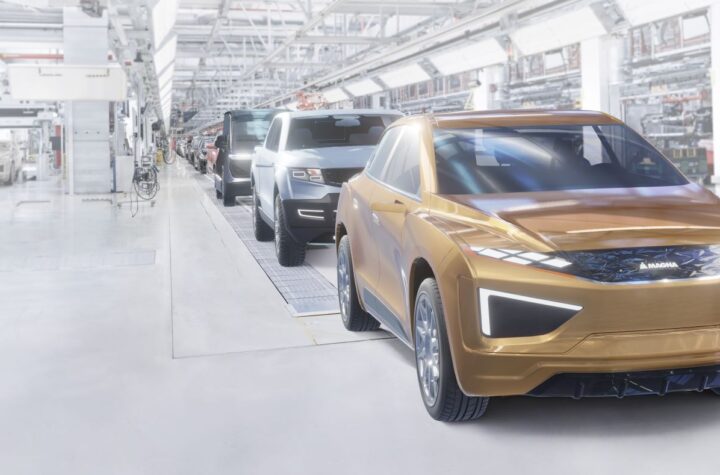
Putting a Price on Supplier Innovation
 |
| Is this system profitable at $4,500 retail and a 25,000 unit/year take rate? Four key components make up the Quadrasteer system — a live axle fitted with steering knuckles, a unique electric motor-driven actuator, ECU and front-wheel position sensor. Although GM had been working on 4WS for many years, none of this hardware and software was “on the shelf” when Delphi was spun off as a separate company. |
Through May, sales of 2003 model trucks equipped with the Quadrasteer option were surprisingly weak, running in the sub-15,000 unit range, reports a GM spokesman. That’s peanuts considering CSM forecasts sales of the four vehicles offering the optional system (GMC Sierra and Yukon XL, Chevrolet Silverado and Suburban) to eclipse 960,000 units this year. The prospect of a meager 0.02 percent take rate for this system after two years in the marketplace has disappointed both the OEM and supplier sides of the program.
The industry is watching Quadrasteer’s fortunes, in what has become a lesson in how OEM packaging and pricing strategies can impact new supplier technologies. With increasing pressure on already slim profit margins, suppliers must carefully weigh their investment in new products. Delphi’s chassis systems competitors, along with Ford, DaimlerChrysler, Nissan and Toyota, are waiting to gauge the effectiveness of GM’s plan to kick-start sales of its sputtering 4WS system.
These companies realize Quadrasteer could be a minor game-changer within the full-size truck segment. Integrating an electronically- controlled steering axle on the rear of the vehicle allows greatly improved maneuvering in tight parking situations. It also adds a comforting sense of stability during trailer towing. Quadrasteer is the answer to the prayers of owners of large, long-wheelbase pickups and SUVs who are daunted each time they try to parallel park or tow the boat in a crosswind. By comparison, the early 4WS systems offered briefly by Honda and Mazda on a few sedans and coupes in the 1980s were answers to questions no one asked. The sales upside of 4WS is significant, even within the stable volumes in full-size trucks forecast by CSM. For suppliers, Quadrasteer represents a “Level 1” product on the sourcing totem pole. (By comparison Level 4 is a commodity.) It delivers high value to the OEM by providing the vehicle owner with tangible safety and convenience benefits — attributes the driver can feel and therefore believe in. Quadrasteer is also a relatively high technology product, its control software is able to precisely coordinate front/rear steering with the capability to eventually link with various Delphi chassis-stability systems.
Whether it’s 4WS, or automated manual gearboxes, or the instant-heat cabin heater that’s standard in the new Porsche Cayenne, such notable technologies (see chart) are competitive assets for suppliers positioning themselves outside the low-ball commodity fray. Level 1 products typically create a strong “must have” pull from the OEM. It is this high level of desirability that supports a far better profit scenario for both the supplier and automaker.
With performance that lives up to its billing, Quadrasteer has been backed by solid marketing support befitting a new feature technology. To its credit GM has spent millions advertising the system since its 2002 debut on the GMC Sierra. The TV spots are particularly engaging, showing Quadrasteerequipped trucks squeezing in and out of various tight spots and towing situations.
Curiously, the trucks themselves have not been given special badging of any sort to stir the buzz on the street. The presence of the 4WS system will only occur to sharp-eyed enthusiasts who might notice the rear steering hardware as they pull up behind one of the trucks. It’s remarkable how 32 valves in a V-8 engine are still worthy of their own badge on some decklids, while the Quadrasteer trucks are forced into Stealth-like anonymity.
However, it’s not an option that customers will naturally check off simply on the basis of its name alone. Quadrasteer is not a “no brainer” feature like the second sliding door on minivans. Customers must spend time behind the wheel test-driving the 4WS system before most will realize they need it. Unfortunately this puts the fate of a sophisticated though user-friendly system in the hands of GMC and Chevrolet dealers. The onus of conducting those test drives and educating the customer falls on salespeople who, hopefully, have read the Quadrasteer section of the owner’s manual.
Torpedoed by Price
On the strength of GM’s GMT800 truck sales alone, Quadrasteer ought to be at least a triple, if not a home run, in the marketplace. But it can barely get on base because of a poorly devised packaging and pricing strategy. Its crushing retail price of $4,500 for the stand alone option has impeded the popularity of this technology more than any other single factor. Quadrasteer works great — but is it worth more than the Duramax turbodiesel option? Few truck buyers seem to think so. Those who already cope with towing trailers and maneuvering in tight confines without 4WS will not spend $4,500 to have an easier drive with it.
The drastic changes GM has made for Quadrasteer for 2004 reflect the realities of the marketplace. Talk about rethinking your business plan — GM is slashing the system’s retail price by more than 50 percent, to a sane $1,995 and astutely reconfiguring what customers get for their money. The package is aimed directly at the trailer-towing crowd and includes a limited slip differential, heavyduty alternator, ride control suspension and roof marker lamps. Also, the 5.3L V-8 is no longer required, making Quadrasteer available with the base 4.8L engine.
There’s more, but it all adds up to wise decisions by GM. Customers wanting 4WS on a mid-range extended-cab 1500-series Sierra SLE, for example, will get their 2004 truck for $33,500, rather than this year’s $38,000. Lower-cost versions of Quadrasteer with greater chassis-integration capability are in development while other suppliers have prepared their own versions of electronic 4WS.
While the new pricing/packaging strategy is welcome news at Delphi, the public will learn about it only in the showroom. GM says Quadrasteer advertising will continue, but it will not include specific reference to the price reduction. Communication about the new pricing will be to dealers — period. That’s a mistake and a lost opportunity to get Quadrasteer on millions of new radar screens. As automakers seek to avoid developing product technologies that the customer won’t pay for, Quadrasteer’s first few years in the marketplace provides a lesson in putting a price on innovation.
| Profit-boosting Technologies By adding these features, OEMs have forced competitors to match them while wooing new customers to their showrooms. | |
| Adjustable pedals Ford’s leadership gave superior ergonomics to 5thpercentile customers, forced other automakers to play catch-up. |  |
| Fold-flat 3rd seats A home-run for Honda in minivan market — a win/win for OEM and seat supplier, quickly became industry standard feature. |  |
| Folding hard tops Mercedes and its top-systems supplier made SLK system the benchmark in drop-top segment. |  |
| Hydroformed structures Set new performance standard for body-onframe vehicles, turned a nonplayer in truck frames into the market leader. |  |
| Variable cylinder displacement New supplier technology resurrects a clever old concept to squeeze more fuel efficiency out of gasoline engines. GM and Honda are committed; DCX, Ford, also may play. |  |
Lindsay Brooke is senior manager of Market Assessment, CSM WorldWide Inc. LindsayBrooke@csmauto.com. www.CSMAuto.com













More Stories
From Gasoline Powered Cars To Electric Vehicles | Electric Moped Bike A Best Alternative
Rubbernecking: A Silly Reason for Car Accidents
Flexible Magna Manufacturing Solutions: The Key to Success in the Automotive Industry